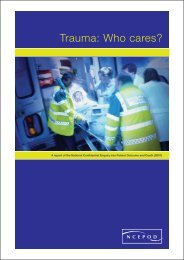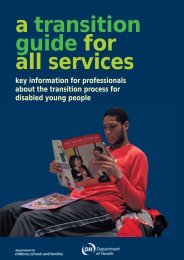(CAMHS) and Schools - London Health Programmes
(CAMHS) and Schools - London Health Programmes
(CAMHS) and Schools - London Health Programmes
You also want an ePaper? Increase the reach of your titles
YUMPU automatically turns print PDFs into web optimized ePapers that Google loves.
‘everybody knowing what is happening with specific student, having the whole<br />
picture, families not having to meet lots of different professionals with different<br />
approaches to their problems, different assessments etc’. (SENCO)<br />
6.4 More appropriate referrals to <strong>CAMHS</strong><br />
The implications of the greater accessibility of CAMH service is of increased<br />
referrals, <strong>and</strong> indeed in some case study areas (<strong>and</strong> some responses from the<br />
questionnaires) referral rates had increased, especially from schools. However, the<br />
main finding from the case studies is that more appropriate referrals were coming to<br />
<strong>CAMHS</strong>. For example it was stressed that multi-referrals (a child, for example, being<br />
referred by their GP <strong>and</strong> by the school SENCO at the same time) were being avoided.<br />
Working in joint teams with shared information means that it avoids different people<br />
working with a child without knowing it.<br />
‘I just closed one (case) today <strong>and</strong> it was a young man who came via the health route.<br />
I’m not suggesting that his problems were only school problems but the immediate<br />
things to do to relieve the situation were school based. That was done very quickly in<br />
the first meeting <strong>and</strong> that was because the relevant education welfare officer was<br />
sitting next door <strong>and</strong> I could say “can you see this child?”, <strong>and</strong> set various things in<br />
motion which took care of three quarters of the problem.’ (<strong>CAMHS</strong> Co-ordinator)<br />
One manager where there were joint teams described the rationale for the structure<br />
was to prevent the whole concept of ‘referral’ where responsibility of the case is<br />
passed on from person to person. Rather, there is a joint responsibility within the team<br />
for the case.<br />
Other workers identified that if a referral was inappropriate, they would find that out<br />
straight away rather than having to wait.<br />
‘If it is an inappropriate referral we know straight away rather than waiting to get to<br />
top of waiting list <strong>and</strong> then finding out.’ (EWO)<br />
6.5 Supportive network for school staff<br />
It was identified that a supportive network was provided for primary care workers,<br />
including teachers, which equipped school staff to deal with issues. Findings from the<br />
Southwark <strong>and</strong> Portsmouth evaluations identified increased underst<strong>and</strong>ing <strong>and</strong><br />
confidence in health issues among Tier 1 staff (school staff in Portsmouth). Interview<br />
findings supported this from both the health service staff <strong>and</strong> the education staff.<br />
Teachers spoke of knowing who they could go to for support. This led to staff feeling<br />
more supported <strong>and</strong> confident in their role. Other teachers mentioned the impact on<br />
their staff when they knew that children with behavioural problems were being seen to<br />
be addressed. Several teachers identified the space it gave them when certain children<br />
with behavioural problems spent time out of the classroom with health staff for work<br />
or therapy. It enabled teachers to concentrate on teaching. Also it allows teachers to<br />
discuss problems <strong>and</strong> ‘off load’ onto health staff.

















